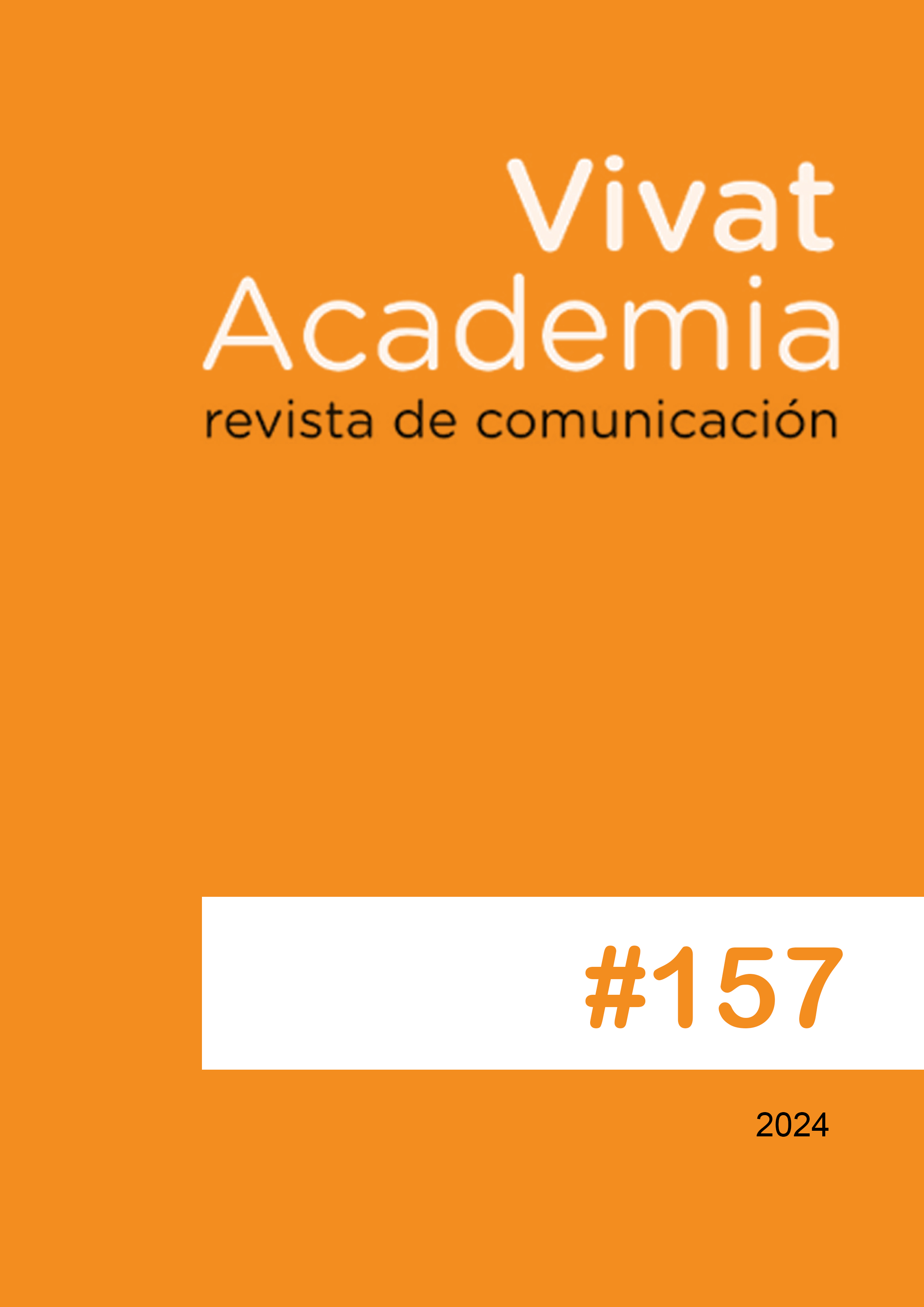Use of collaborative tools and remote work in the production of news programs in Canal Sur Television after COVID-19 The case of Despierta Andalucía
Main Article Content
Abstract
Introduction. This paper examines the persistence of technologies and production models in information production that were used during the pandemic. For instance, the use of collaborative video call tools in live broadcasts, telecommuting, and other applications that have continued even after the lifting of the state of emergency. Methodology. The study employs a mixed-methods approach, combining both qualitative and quantitative elements. To achieve the stated objectives, three data collection instruments were utilized: interviews, surveys, and participant observation. By employing these tools, a comprehensive and in-depth understanding of the phenomenon under study was sought, enabling the capture of both subjective and objective aspects. Discussion and Results. The use of these software programs by writers, producers, and directors at Radio Televisión Andaluza is examined, particularly in the daily news program "Despierta Andalucía." Through the partial implementation of telecommuting and collaborative tools, this program manages to surpass the efficiency and productivity levels observed prior to the COVID-19 pandemic. Conclusions. Collaborative tools that were employed during the pandemic have become efficient and cost-effective means of production, and therefore, have been maintained in the majority of cases. This is especially true for the use of video conferencing applications for live broadcasts.
Downloads
Article Details

This work is licensed under a Creative Commons Attribution-NonCommercial-ShareAlike 4.0 International License.
References
Anguita, J. C., Labrador, J. R., Campos, J. D., Casas Anguita, J., Repullo Labrador, J. y Donado Campos, J. (2003). La encuesta como técnica de investigación. Elaboración de cuestionarios y tratamiento estadístico de los datos (I). Atención primaria, 31(8), 527-538. https://doi.org/10.1016/S0212-6567(03)79222-1
Alshenqeeti, H. (2014). Interviewing as a data collection method: A critical review. English linguistics research, 3(1), 39-45. https://doi.org/10.5430/elr.v3n1p39
Bauder, D. (2010). Networks using Skype in news reports. The San Diego Union-Tribune. https://bit.ly/3UyqDNl
Blas Blas, J., García García, A. y Martín Moraleda, I. J. (2020). COVID-19: Contenidos audiovisuales a partir del uso de herramientas domésticas. Revista de Comunicación y Salud, 10(2), 25-61. https://doi.org/10.35669/rcys.2020.10(2).25-61
Bringas Cespedes, J. J. (2022). Gestión de herramientas colaborativas para la labor periodística: Manual de Estilo bajo el enfoque de Desing Thinking [Tesis Doctoral. Universidad César Vallejo]. Repositorio de la Universidad César Vallejo. https://bit.ly/3UvTrpG
Catalano, A. (2022). Mundial de Qatar: las mochilas con tecnología móvil potencian la creación y transmisión de contenidos. TeleSemana. https://bit.ly/3G81C5G
Díaz-Arias, R., Sotelo-González, J., Rodríguez-Pérez, C., Aparicio-González, D. y López-Frías, C. (2021). Informativos estatales de televisión en España en tiempos de COVID-19. Cambios formales, de tratamiento y de contenido. Estudos em Comunicação, 32, 95-135. https://bit.ly/41Haacj
Edelsburg, N. (2015). How Skype is integrating with television shows around the globe. The Drum. https://bit.ly/3Uu9018
Jiménez, M. (2020). Los ganadores empresariales de la pandemia son tecnológicos. CincoDías. https://bit.ly/3U2JXSI
Khanvilkar, S. y Khokhar, A. (2004). Virtual private networks: an overview with performance evaluation. IEEE Communications Magazine, 42(10), 146-154. https://doi.org/10.1109/MCOM.2004.1341273
Las-Heras-Pérez, E. (2016). Flujos de trabajo (workflows) en los informativos tras la digitalización: El caso de Canal Sur Televisión [Tesis no publicada]. Universidad de Sevilla.
Masip, P., Aran-Ramspott, S., Ruiz-Caballero, C., Suau, J., Almenar, E. y Puertas-Graell, D. (2020). Consumo informativo y cobertura mediática durante el confinamiento por el COVID-19: sobreinformación, sesgo ideológico y sensacionalismo. El Profesional de la Información, 29(3), 1-12. https://doi.org/10.3145/epi.2020.may.12
Moreno, Á., Fuentes-Lara, C. y Navarro, C. (2020). COVID-19 communication management in Spain: Exploring the effect of information-seeking behavior and message reception in public’s evaluation. El Profesional de la información, 29(4), 1-16. https://doi.org/10.3145/epi.2020.jul.02
Olivares García, F. J., Roman San Miguel, A. y Méndez Majuelos, I. (2022). Las redes sociales como herramienta de comunicación periodística: La estrategia de comunicación digital de Volodímir Zelenski durante la guerra de Ucrania. VISUAL REVIEW. International Visual Culture Review/Revista Internacional de Cultura Visual, 9(Monográfico), 1-12. https://doi.org/10.37467/revvisual.v9.3660
Oliver, M. Á. (2017). El género de la noticia en la práctica: Edición, contenidos y escaleta del informativo de televisión. En Reporterismo de televisión: guía de buenas prácticas del reportero audiovisual (pp. 69-84). Gedisa.
Rodríguez-Gallego, M. R., Gómez-del-Castillo, M. T. y Ordóñez-Sierra, R. (2022). Liderazgo compartido por los tutores académicos de prácticas a través de una herramienta colaborativa. Revista Prácticum, 7(1). 72-87. https://doi.org/10.24310/RevPracticumrep.v7i1.12568
Román-San-Miguel, A. (2020). Periodismo mediado en televisión. Uso y abuso de las plataformas de videollamada durante el Estado de Alarma en España. En S. Martínez Martínez, P. E. Rivera Salas y M. O. Luque Colmenero. Los nuevos lenguajes del audiovisual (pp. 437-449). Tirant Humanidades.
Statista.com (2020). Ranking de los medios de comunicación más utilizados por la población para informarse sobre el coronavirus en España a fecha de marzo de 2020. https://bit.ly/3zS3Q5N
Taylor, S. J. y Bogdan, R. (1987). Introducción a los métodos cualitativos de investigación: La búsqueda de significados. Paidós.
Túñez-López, M., Vaz-Álvarez, M. y Fieiras-Ceide, C. (2020). COVID-19 y medios de servicio público: impacto de la pandemia en la televisión pública en Europa. El Profesional de la Información, 29(5). https://doi.org/10.3145/epi.2020.sep.18
Veloz Segura, V. T., Moreno del Pozo, G. F. y Bonilla Roldán, M. A. (2022). El uso de herramientas colaborativas en la educación virtual dentro del proceso enseñanza - aprendizaje en estudiantes de bachillerato. Revista Kilkana Sociales, 6(3), 33-46. https://doi.org/10.26871/killkanasocial.v6i3.960
Artículos relacionados
Abuín-Penas, J. y Abuín-Penas, R. (2022). Redes sociales y el interés por la información oficial en tiempos de pandemia: análisis de la comunicación de los ministerios de salud europeos en Facebook durante la COVID-19. Revista de Comunicación y Salud, 12. https://doi.org/10.35669/rcys.2022.12.e303
Aguado-Guadalupe, G. y Bernaola-Serrano, I. (2020). Verificación en la infodemia de la Covid-19. El caso Newtral. Revista Latina de Comunicación Social, 78, 289-308. doi.org/10.4185/RLCS-2020-1478
Alonso González, M. (2021). Desinformación y coronavirus: el origen de las fake news en tiempos de pandemia. Revista de Ciencias de la Comunicación e Información, 26, 1-25. https://doi.org/10.35742/rcci.2021.26.e139
Castro-Martínez, A., Díaz-Morilla, P. y Torres-Martín, J. L. (2022). El papel de la comunicación interna en la gestión del teletrabajo durante la crisis de la COVID-19. Revista de Comunicación de la SEECI, 55, 29-51. https://doi.org/10.15198/seeci.2022.55.e768
Ruiz Torres, P. (2021). COVID-19: Teletrabajo en tiempos de pandemia. Historia y Comunicación Social, 26(Especial), 11-18. https://doi.org/10.5209/hics.74237





